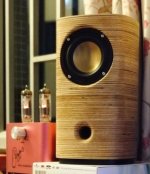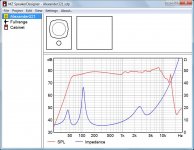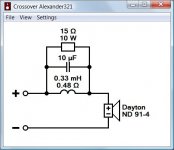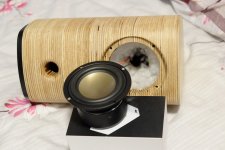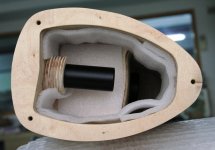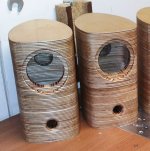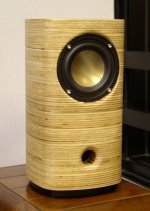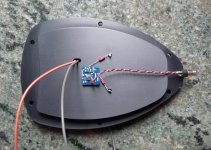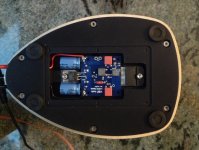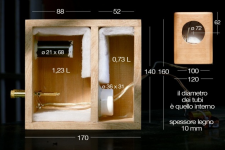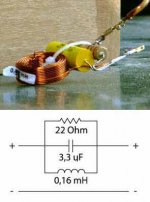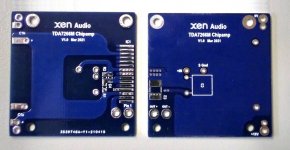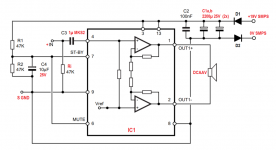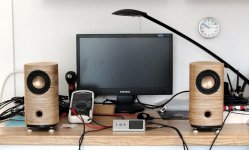Hello,
I want to build a pair of small speakers that can reach lower and play louder than their size suggests. I stumbled upon the Mini DCAAV project . Originally it was designed for HIVI B3N.
As I can see the design is suitable for different 3" drivers like the Tangband W871:
Or Fountek Fe85:

My question is: can I use this design without modification for the Dayton ND91 (the successor to the ND90 which is basically the Aura NS3)
and will it require a notch filter. Also I think the 4ohm version will be better suited for my Sure TA2024 amp (2x15watts) ?
I want to build a pair of small speakers that can reach lower and play louder than their size suggests. I stumbled upon the Mini DCAAV project . Originally it was designed for HIVI B3N.
An externally hosted image should be here but it was not working when we last tested it.
As I can see the design is suitable for different 3" drivers like the Tangband W871:
An externally hosted image should be here but it was not working when we last tested it.
Or Fountek Fe85:

My question is: can I use this design without modification for the Dayton ND91 (the successor to the ND90 which is basically the Aura NS3)
and will it require a notch filter. Also I think the 4ohm version will be better suited for my Sure TA2024 amp (2x15watts) ?
Last edited:
Get WinISD and put in box volume and driver parameters. It is a bass reflex so pick a convenient port dia (same as used on those designs) and adjust tuning freq until you see what you like and set port length. By notch filter I think you mean baffle step compensation (BSC) filter? It is more of a high freq attenuation shelf filter to help bring out the bass that is attenuated due to the baffle step loss. There are calculators out there and you can copy previous design if driver efficiency and nominal impedance is the same. You can also play with it and adjust to taste. Buy a larger than needed air core inductor (say 1 mH) and if it is too much reduce length by snipping. Use a 3 to 6 ohm resistor in parallel ( get several values and play with it). Wire the coil and resistor in parallel and connect in series with positive terminal between driver and amp. When it sounds like the balance between bass and treble is good, the BSC is correct. If it sounds too bright, increase R.
Our version of the DCAAV. 😉
Patrick
That looks awesome !!
Can you give me more info on the project?
🙂
Get WinISD and put in box volume and driver parameters. It is a bass reflex so pick a convenient port dia (same as used on those designs) and adjust tuning freq until you see what you like and set port length. By notch filter I think you mean baffle step compensation (BSC) filter? It is more of a high freq attenuation shelf filter to help bring out the bass that is attenuated due to the baffle step loss. There are calculators out there and you can copy previous design if driver efficiency and nominal impedance is the same. You can also play with it and adjust to taste. Buy a larger than needed air core inductor (say 1 mH) and if it is too much reduce length by snipping. Use a 3 to 6 ohm resistor in parallel ( get several values and play with it). Wire the coil and resistor in parallel and connect in series with positive terminal between driver and amp. When it sounds like the balance between bass and treble is good, the BSC is correct. If it sounds too bright, increase R.
Thanks for the detailed response!
I will try that too but I guess that a single chamber BR with the same tuning freq will be a lot bigger than the DCAAV
There are multi chamber BR calculators available. Search and you will see an excel spreadsheet. Also can be done in AkAbak. Look in a previous thread by IG81 on the Tang Band W4 bamboo driver. Lots of links in there on how to calculate.
I guess that a single chamber BR with the same tuning freq will be a lot bigger than the DCAAV
I don't know how the Dayton performs in the double chamber cabinet, but it goes quite low in a single chamber of the same size (internal volume 2.1 liters). Vent dimensions would be 21 x 120 mm. Don't expect much treble above 8 kHz.

Attachments
I don't know how the Dayton performs in the double chamber cabinet, but it goes quite low in a single chamber of the same size (internal volume 2.1 liters). Vent dimensions would be 21 x 120 mm. Don't expect much treble above 8 kHz.
Thank you for calculating all the things for me ! :]
So you suggest me to add a tweeter and cross them over at 8khz ?
If you have any other recommendations please share them 🙂
(so far I don't have the drivers , just doing research and the dayton ND91-4 seems like one of the few small drivers that can actually play real bass and go low enough)
Last edited:
A lot of moderate to high Qts drivers in the 3 in to 4 in range will reach 50 to 60 Hz in a simple BR enclosure. The $12 Vifa TC9FD hits 55 Hz easily and reaches all the way to 18 kHz. No crossover, no tweeter needed.
> Can you give me more info on the project?
Same as the original DCAAV in volume and pipe size.
Just different shapes.
Frequency response is as flat as you can get from a wide band.
Sounds great, so no need to change anything.
(We tried using the original Italian software; did not make it any better with our changes.)
A picture is worth more than a thousand words.
So here are a few thousand.
This is part of the XEN Audio team project for a PC speaker.
Source is a USB DAC using ES9023 in balanced mode.
The bottom plate of the speaker is milled from solid aluminium, with a LM1876 inside, also in balanced mode.
http://www.diyaudio.com/forums/head...nheiser-hd650-vs-akg-q701-qj.html#post3297365
🙂
Patrick
Same as the original DCAAV in volume and pipe size.
Just different shapes.
Frequency response is as flat as you can get from a wide band.
Sounds great, so no need to change anything.
(We tried using the original Italian software; did not make it any better with our changes.)
A picture is worth more than a thousand words.
So here are a few thousand.
This is part of the XEN Audio team project for a PC speaker.
Source is a USB DAC using ES9023 in balanced mode.
The bottom plate of the speaker is milled from solid aluminium, with a LM1876 inside, also in balanced mode.
http://www.diyaudio.com/forums/head...nheiser-hd650-vs-akg-q701-qj.html#post3297365
🙂
Patrick
Attachments
So you suggest me to add a tweeter and cross them over at 8khz ?
No, I'm not suggesting anything. I only wanted to show that the Dayton not necessarily needs a double chamber bass reflex to achieve some low frequency extension. The drivers used in the Mini DCAAV have higher Fs and Qts, thus one has to apply some tricks to make them play lower than 100 Hz. In this respect, the Dayton is an outstanding driver and hard to beat. But there is also a downside, the sensitivity is low and the top end is limited.
The major challenge in full range speaker design is to find a driver which equally performs well in bass and in treble. There are plenty of threads here discussing pro and con of different drivers. Also worth a look is Zaph's conclusion: Zaph|Audio
The other option is to stay with the Dayton and to add a tweeter. For example, I have the Aura NS3 right here on my desk. After 5 minutes of listening it was clear to me that I would need a tweeter, because there is little treble on axis and almost none off axis. If you decide to go 2-way, this thread might be interesting:
http://www.diyaudio.com/forums/mult...ay-micro-bookshelves-need-crossover-help.html
We finished another 10 pieces this years.
These have inside their base plates a LM1876 chipamp driven in balanced mode.
For single ended source, balanced conversion is done by a THAT1646.
Make very nice desk top computer active speakers.
Power is supplied by a 19V 45W laptop SMPS, with BUF634 rail splitter.
Patrick
.
These have inside their base plates a LM1876 chipamp driven in balanced mode.
For single ended source, balanced conversion is done by a THAT1646.
Make very nice desk top computer active speakers.
Power is supplied by a 19V 45W laptop SMPS, with BUF634 rail splitter.
Patrick
.
Attachments
Last edited:
Original design notch filter schematics?
I realise that this is an old thread but I'm hoping to build the original design using B3N's.
However the site appears to gone (and the original author uncontactable - I tried).
While the dimensions are readily available, I haven't been able to find the values/schematic for the notch filter.
Would anyone have saved this? If so would really appreciate a copy!
I realise that this is an old thread but I'm hoping to build the original design using B3N's.
However the site appears to gone (and the original author uncontactable - I tried).
While the dimensions are readily available, I haven't been able to find the values/schematic for the notch filter.
Would anyone have saved this? If so would really appreciate a copy!
> However the site appears to gone (and the original author uncontactable - I tried).
Audiocostruzioni - Il Portale dell'alta fedelt? amatoriale
See also attached.
Patrick
.
Audiocostruzioni - Il Portale dell'alta fedelt? amatoriale
See also attached.
Patrick
.
Attachments
Some of us still have not finished theirs after 5 years.
And some now want a simpler solution for single-ended input.
So instead of LM1876 bridged with a THAT1646, we found another solution after much searching.
The TDA7266M (mono) will do everything we want with very few external components.
And will work at a wide supply voltage range.
We intend to use 12V and 18V from notebook SMPS, as before.
Patrick
.
And some now want a simpler solution for single-ended input.
So instead of LM1876 bridged with a THAT1646, we found another solution after much searching.
The TDA7266M (mono) will do everything we want with very few external components.
And will work at a wide supply voltage range.
We intend to use 12V and 18V from notebook SMPS, as before.
Patrick
.
Attachments
Someone asked for my TDA7266 PCBs.
I have none left, and it was designed to fit those speakers.
For general purpose, you can simply build using a strip board.
As shown here :
https://electro-dan.co.uk/electronics/TDA7297_TDA7266.aspx
Patrick
I have none left, and it was designed to fit those speakers.
For general purpose, you can simply build using a strip board.
As shown here :
https://electro-dan.co.uk/electronics/TDA7297_TDA7266.aspx
Patrick
- Home
- Loudspeakers
- Full Range
- Mini DCAAV with Dayton ND91 ?
